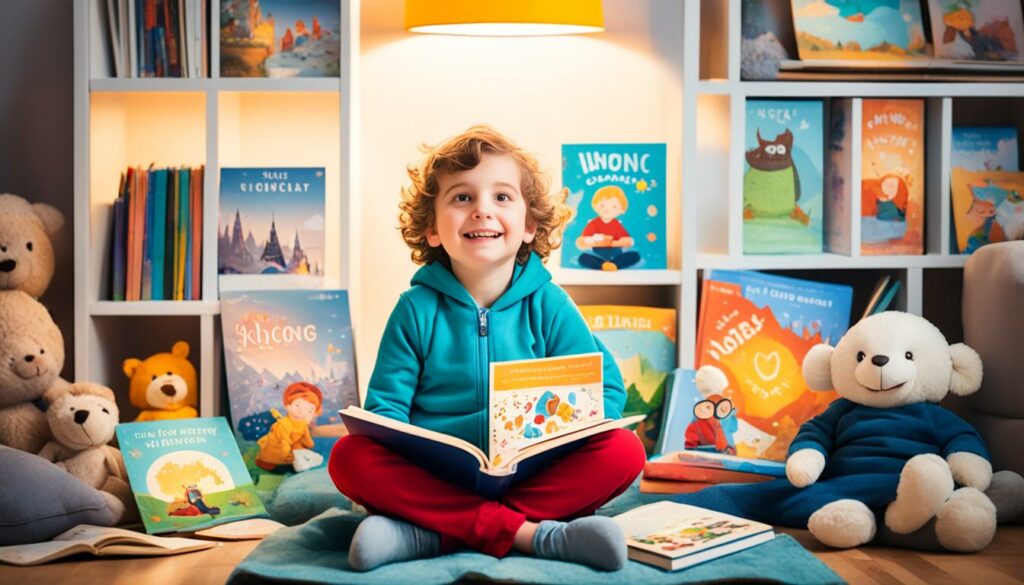Picture the happiness on your child’s face when the two of you cuddle up on the couch, book in hand, prepared for a journey through the pages of a story. The soothing sound of your voice, the vibrant illustrations that spring to life with every page turn – it’s a enchanting moment that not only encourages a love for reading but also sparks a desire for learning.
Reading aloud to your child is more than just a bonding experience. It is a powerful tool that can boost their early literacy skills and set them on a path to success in school and beyond. According to research by Dunst et al. (2013)1, engaging in literacy experiences at home can positively impact a child’s reading ability, comprehension, and language skills. It’s never too early to start, and the benefits are immense.
From the moment your child is born, their brain is like a sponge, ready to soak up all the language and knowledge in the world. By making reading a part of your daily routine, you expose them to the wonders of language acquisition and emergent literacy1. Nursery rhymes, in particular, have been noted to be beneficial for language and early literacy development in young children1. The simple act of playing audiobooks or reading aloud at home can increase the amount of language a child hears, aiding in their literacy development1.
As your child grows older, their literacy needs evolve. For older children, playing word games, discussing word meanings, and pointing out new words while reading together can enhance their literacy skills1. It’s not just about reading the words on the page; it’s about understanding and making connections. Engaging in conversations, providing a literacy-rich environment, and modeling reading behavior are key strategies for adolescents’ literacy development1.
Technology has also become a valuable tool for literacy development. Utilizing technology, such as educational apps and interactive e-books, can help children enhance their language skills and broaden their background knowledge1. Families are encouraged to serve as “media mentors” and have discussions with children about using technology in creative ways to boost their literacy skills1.
So start today, and embark on a reading journey with your child. Spark their imagination, nourish their language skills, and lay the foundation for a lifetime of learning. Together, you can boost your child’s early literacy skills and open doors to a world of opportunities.
Key Takeaways:
- Engaging in literacy experiences at home can positively impact a child’s reading ability, comprehension, and language skills1.
- Reading aloud from day one is important for children’s literacy development2.
- Playing audiobooks or reading aloud at home can increase the amount of language a child hears, aiding in their literacy development1.
- Playing word games, discussing word meanings, and pointing out new words while reading together can enhance literacy skills in older children1.
- Utilizing technology as a tool for literacy development can help children enhance their language skills and background knowledge1.
Importance of Starting Early
Starting early in reading to your baby is essential for their healthy brain development and the development of language and writing skills. It is never too early to begin this journey with your little one. By exposing them to language through reading at a young age, you are helping to build the foundation for their future literacy skills and fostering a love for books that will stay with them as they grow.
Research has shown that reading aloud to children from birth helps build crucial brain connections during the first 5 years of their life, which is when 90% of their brain development occurs3. These early literacy experiences lay the groundwork for future success in school and life. In fact, the number of words a child knows at kindergarten entry predicts their future academic achievements3. Unfortunately, over 1 in 3 American children start kindergarten without the necessary skills to learn to read effectively3.
Reading aloud to babies not only exposes them to language and helps build their vocabulary but also forms a positive association between books, reading, and loved ones. This association can motivate them to read more as they grow3. Engaging in activities like reading, talking, singing, and playing with young children enhances their language, literacy, social, and emotional skills, and strengthens the bond between parent/caregiver and child3.
Moreover, early literacy skills have far-reaching benefits in life. Literacy positively impacts a person’s life by reducing the risk of poverty, increasing chances of employment, enhancing social inclusion, and promoting overall health3. Unfortunately, adults with low literacy skills face challenges in accessing and utilizing healthcare services for themselves and their children, leading to potential developmental and health risks3.
By starting early and reading to your baby, you are setting them up for a lifelong love of reading and providing them with the tools they need for success. It’s never too early to start this beautiful journey of exploring books together and nurturing their growing minds.

Sources:
- Statistical data from Link 1
Establishing a Routine
When it comes to fostering a love for reading in your child, establishing a routine plays a vital role in ensuring consistency and creating a special bonding experience. Setting aside specific times for reading, such as during naptime and bedtime, not only establishes a predictable schedule but also provides you and your child with cherished moments to look forward to every day.
Routines are essential for creating structure in a child’s day and can be customized to suit your family’s needs and preferences. By incorporating reading into your daily routine, you make it a natural and enjoyable part of your child’s day-to-day life.
Research has shown that routines offer children a sense of comfort and predictability in their environment, making them more receptive to learning and engagement4. By making reading a regular part of your daily routine, you provide your child with a consistent and familiar opportunity to develop their language skills and nurture their love for books.
Naptime reading can be a peaceful and tranquil moment, providing a calm environment to explore stories and build vocabulary. As your child settles down for a restful nap, you can indulge them in the world of books, creating delightful associations between relaxation and reading.
Bedtime reading, on the other hand, offers an opportunity for quality parent-child bonding and a chance to wind down before sleep. Through the soothing act of reading bedtime stories, you create lasting memories and a sense of security for your child, encouraging a lifelong love for reading.
By incorporating reading into established routines, you ensure that it becomes an integral part of your child’s daily life and a habit that they carry with them as they grow older. These consistent and predictable reading sessions create a strong foundation for literacy development and a lifelong passion for books.
So, make it a point to include daily reading sessions in your routine, bringing the joy of books into your child’s life in a predictable and meaningful way. Remember, a daily routine filled with reading is not only beneficial for your child’s language and literacy development, but it also strengthens the bond you share through shared experiences and cherished moments.
Age-Appropriate Books
As your child grows, it is important to choose age-appropriate books that cater to their developmental stage. For babies, board and cloth books are great options, as they allow for tactile exploration and are safe for mouthing. These books help babies develop their fine motor skills and engage with the story through touch.
Research has shown that within their first 18 months, most infants show an understanding that pictures symbolize things in the real world, with unique human comprehension5. By engaging with board and cloth books, babies can further develop their literacy skills by noticing print in addition to pictures between 15 and 20 months5. These books provide a valuable opportunity for parents to share words and stories with their child, expanding their vocabulary and aiding in word comprehension5.
Not only do age-appropriate books support early literacy development, but they also introduce descriptive words rarely found in everyday speech, contributing to vocabulary growth. For example, books like “The Napping House” use descriptive words related to napping, which can enhance a child’s vocabulary5.
| Type of Book | Target Age Group | Description |
|---|---|---|
| Board Books | 0-2 years | Sturdy and durable, perfect for little hands to explore |
| Cloth Books | 0-2 years | Soft and interactive, ideal for sensory development |
When selecting age-appropriate books, consider the developmental milestones your child has reached. By choosing books that align with their age and interests, you can foster a love for reading and create a positive reading experience.
Children also learn print conventions, such as reading from left to right and top to bottom, by engaging with books at a young age5. The structure of a book, with a beginning, middle, and end, becomes familiar to them, laying the foundation for future reading comprehension skills and a deeper understanding of story structure.
One wonderful example of an age-appropriate book is “Knuffle Bunny.” This book can enrich a child’s life with affirming experiences, strengthen the parent-child relationship through shared emotional connections, and support emerging literacy by teaching story structure5.

Remember, age-appropriate books play a crucial role in nurturing your child’s literacy development. By choosing board books and cloth books tailored to their age, you provide them with engaging and enriching reading experiences that promote growth in fine motor skills, vocabulary, and early literacy skills.
Interactive Reading
Make reading an interactive experience by actively engaging your child in the story. This not only enhances their enjoyment of the book but also promotes important language and comprehension skills. By asking questions, encouraging predictions, and discussing their favorite parts, you can create a rich reading experience that stimulates their story comprehension and fosters a deeper connection with the text.
When reading together, try incorporating open-ended questions that encourage critical thinking and reflection. For example, you could ask:
“What do you think will happen next?”
“Why do you think the main character made that decision?”
“Can you relate this part of the story to something that has happened in your own life?”
These types of questions prompt your child to think beyond the surface level of the story and delve into underlying themes, motivations, and emotions. Building the habit of asking questions during reading also helps develop their analytical and inferential thinking skills.
In addition to asking questions, encourage your child to make predictions about the story’s outcome. This can be a fun and engaging activity that keeps them actively involved in the narrative. You can also encourage them to share their favorite part of the story and explain why it resonated with them. This not only strengthens their understanding and memory of the text but also nurtures their personal connection to literature.
The benefits of interactive reading are supported by research. Studies have shown that interactive reading builds listening comprehension, which is crucial for young students6. It provides oral language opportunities that are essential for building vocabulary and knowledge6. Interactive read-alouds also help bridge the gap between spoken and written language, promoting literacy development6.
Remember that the choice of texts is also important in interactive reading. Carefully selecting texts that align with your child’s interests, reading level, and educational goals is key to boosting early literacy skills6. Texts can vary widely, including poetry, song lyrics, images, video clips, letters, and nonfiction texts6. As you explore different genres and formats, you’ll find opportunities to engage your child in unique and captivating ways.

The image above depicts a parent and child reading together and engaging in interactive reading. The parent asks questions about the story, while the child eagerly participates in the discussion, fostering a deeper understanding and connection to the text. By incorporating interactive reading techniques into your daily reading routine, you can ignite your child’s curiosity, stimulate their imagination, and cultivate a lifelong love for books.
Repetition and Word Recognition
Repeatedly reading your child’s favorite books can have a significant impact on their word recognition skills and reinforce the structure of the story. As they grow, they will start completing sentences in familiar stories and recognizing letters. By pointing out words that begin with the same letter, you can further enhance their letter recognition skills.7
Repetition plays a crucial role in helping children develop their word recognition abilities. According to research conducted by Gough & Tunmer (1986), children need to develop both fluent word reading and language comprehension to become proficient readers.7
“Fluent word reading is supported by underlying skills such as phonological awareness, phonics, decoding, and automatic word recognition,” explains Wolf (2018). Automatic word recognition enables reading to be fluent, accurate, and expressive, with minimal attention resources required by the brain.7
Proficient readers possess a vast sight vocabulary, allowing them to recognize a large number of words instantly and automatically, as highlighted by Pace Miles & Ehri (2019). They read practically all words from memory by sight, thanks to the mental process known as orthographic mapping, as described by Ehri (2014). Orthographic mapping helps proficient readers instantly read any familiar word.7
For children to automatically recognize many words, they need to develop phonemic awareness and phonics and decoding skills, as emphasized by Kilpatrick (2016). Through reading practice, orthographic mapping occurs, contributing to the development of fluent word recognition, as noted by Henbest & Apel (2018). It is also essential for English learners to have equal opportunities for foundational skills instruction, which supports automatic word recognition.7
Repeated oral reading activities with feedback and guidance can be particularly beneficial for English learners, aiding in both word recognition and confidence development, according to Linan-Thompson & Vaughn (2007). These activities allow children to practice reading, refine their skills, and become comfortable with words and their meaning.7
Enhancing Word Recognition Skills through Repeated Readings
Repeated readings play a vital role in helping children master the storyline, ideas, and language of a story, enabling comprehension and deeper engagement. Research shows that repeated story readings effectively enhance preschool children’s understanding, as well as their ability to talk about and comprehend stories.8
“Children with speech and language delays can especially benefit from having books read multiple times to notice new things,” states the research. Through repeated reading, children understand unfamiliar words by recognizing sound patterns, specific words, and letter-sound relationships.8
Preschoolers often choose the same book repeatedly on their own, as it helps them develop familiarity with the vocabulary and themes presented. This active participation during repeated book readings enhances vocabulary skills and promotes a deeper understanding of story structure and language patterns.8
Interactive reading, with the inclusion of open-ended questions and periodic pauses, has been proven to improve children’s comprehension and engagement with stories. By asking questions and encouraging children to reflect on the story, interactive reading prompts active involvement and deepens understanding.8
Reading experiences involving tactile elements, such as textured pages, provide enhanced engagement for children with visual impairments. Incorporating concrete objects to represent words in a story can further reinforce vocabulary acquisition during interactive reading sessions.8
Importance of Phonics for Word Recognition
Recent reviews of major commercial reading programs have revealed the inadequately represented word-recognition instruction within these programs. Stein et al. emphasized the importance of explicit phonics instruction, a key approach that fewer programs include.9
Hundreds of supplementary phonics programs are available on the market, specifically designed for students with reading disabilities. Some of these programs combine traditional materials with audiotapes, electronic games, and computer discs to enhance learning and engagement.9
Phonics instruction’s primary goal is to assist children in understanding the alphabetic system of written English. It focuses on teaching important and regular letter-to-sound relationships efficiently, enabling children to comprehend words composed of patterns of letters representing spoken sounds.9
Repeated opportunities for reading are crucial for children to refine and extend their knowledge of letter-sound correspondences. Understanding the alphabetic principle is key to developing strong word recognition skills, enabling children to identify and understand words more easily.9
Children with learning disabilities benefit from organized instruction that centers on sounds, letters, and their relationships. Effective phonics and word-recognition instruction should cover various aspects, including alphabetic knowledge, phonemic awareness, sound-symbol relations, word-identification strategies, spelling connections, reading practice, and reading fluency.9

Counting and Math Skills
As you read to your child, incorporate counting activities by counting objects on the page together. This not only helps develop their early math skills, but also strengthens their object recognition abilities10. Make counting a fun and interactive part of your reading experience by pointing to each object and saying the number aloud. For example, you can count the animals in a picture book or the number of flowers in a garden scene10. By combining reading and counting, you are providing your child with a multisensory learning experience that supports their cognitive development10.
| Benefits of Counting and Math Skills | Ways to Incorporate in Reading |
|---|---|
| Develop early math skills | Count objects on the page |
| Enhance object recognition abilities | Point to each object while counting |
| Improve cognitive development | Combine reading and counting for a multisensory experience |
By counting objects during reading, you are helping your child understand the concept of quantity and learn the connection between numbers and objects10. This lays a solid foundation for their numeracy skills and prepares them for future math learning. Additionally, counting objects on the page can make reading more engaging and interactive, capturing your child’s attention and sparking their curiosity10.
Encourage your child to actively participate in the counting process by asking questions like, “How many apples do you see?” or “Can you find five elephants?” This not only reinforces their object recognition skills10, but also promotes their critical thinking and problem-solving abilities. Through this interactive approach, your child can develop a deeper understanding of numbers and their relationship with the world around them10.
Remember, early math skills are interconnected with language, physical, and social skills development in children10. By integrating counting and math activities into your reading sessions, you are supporting your child’s holistic development and setting them up for academic success in the future10.

Encouraging Storytelling
As your child reaches preschool age, encourage them to tell you stories based on the pictures in the book or to create their own stories. This interactive activity not only fosters their imagination and creativity but also helps them develop vital skills like plot development and storytelling ability11. By engaging in storytelling, your child becomes an active participant in the reading experience, enhancing their enjoyment and understanding of stories12.
Storytelling provides a platform for preschoolers to express their thoughts and ideas, allowing them to practice their language skills and build vocabulary11. Through storytelling, children learn how to structure a narrative, develop characters, and create engaging plotlines. These skills are not only essential for effective communication but also lay the foundation for their future reading and writing abilities.
Encouraging your child to create their own stories also promotes critical thinking and problem-solving skills. As they invent characters, settings, and events, they learn to think logically and make connections between different story elements12. This process facilitates cognitive development and enhances their understanding of cause and effect relationships.
“Once upon a time, in a magical forest, there was a brave little bird called Flutter who embarked on a great adventure to save her friend from an evil witch. Along the way, she met a wise owl who helped her overcome challenges and find her inner strength. In the end, Flutter defeated the witch and learned the importance of friendship and bravery.”
Encouraging your child to tell their own stories also provides an opportunity for you to engage in meaningful conversations and nurture their social and emotional development. Listening to their stories attentively and showing genuine interest fosters a strong bond between you and your child, creating a safe and nurturing environment for them to express themselves and explore their imagination12.

Storytelling has been found to have numerous benefits for children’s literacy and cognitive development. It enhances their listening and comprehension skills as they follow the flow of the narrative and understand the sequence of events12. Additionally, storytelling helps children develop empathy and understanding as they step into the shoes of different characters and experience their emotions and challenges.
As a parent, you can support and enhance your child’s storytelling skills by providing them with a variety of books and resources that ignite their imagination and curiosity13. Visiting the local library, attending storytelling sessions, and borrowing books that allow children to explore different themes and genres can greatly contribute to their overall language development and literacy skills13.
| Benefits of Encouraging Storytelling |
|---|
| Develops imagination and creativity |
| Enhances language skills and vocabulary |
| Builds critical thinking and problem-solving abilities |
| Fosters social and emotional development |
| Improves listening and comprehension skills |
| Develops empathy and understanding |
Encouraging storytelling in preschoolers is a wonderful way to nurture their love for reading and writing while promoting their overall cognitive, emotional, and social development. So go ahead, grab a book, and let your child’s imagination soar through the power of storytelling11!
Reading with Passion
When it comes to reading with your child, adding passion and intonation to your voice can create a memorable reading experience14. By infusing excitement, sadness, or curiosity into your voice at specific points in the story, you can help your child engage with the content on a deeper level. This not only makes reading more enjoyable but also aids in word memorization and comprehension.
Imagine reading a story about a brave knight on a quest. You can use a strong, confident tone when describing the knight’s heroics and a hushed, suspenseful voice during moments of danger. By varying your intonation, you bring the story to life and capture your child’s attention14.
Reading with passion also helps your child remember the words and phrases used in the story. When you emphasize certain words or phrases with excitement or emotion, they become more memorable. Over time, this can improve your child’s word memorization skills and expand their vocabulary14.
Creating Memorable Characters
By giving each character their own unique voice or accent, you can make the story even more engaging and memorable for your child. Whether it’s voicing a pirate with a gruff tone or a fairy with a gentle lilt, these distinctive voices make the characters come alive in your child’s imagination.
“Avast, ye landlubbers!” the pirate exclaimed, his voice booming with excitement. “Arr, there be treasures awaitin’ us on this here island!”
The use of different voices not only adds entertainment value but also helps your child differentiate between characters and reinforces their understanding of the story14.
Emotional Connection through Reading
Reading with passion can also create an emotional connection between you and your child. By conveying the emotions expressed by the characters in the story, you help your child empathize with their struggles and triumphs. This emotional connection cultivates empathy and a deeper understanding of the world around them.
For example, as you read a story about a little girl who overcomes her fear of the dark, you can use a tone filled with encouragement and warmth. Your child will not only resonate with the character but also feel supported and empowered in their own experiences14.
Remember, reading with passion is not only about making the story entertaining but also about fostering a love for books. By creating a memorable reading experience, you instill a sense of joy and excitement in your child, encouraging them to seek out more books and explore the wonders of reading14.

Reading with passion creates a memorable reading experience that fosters word memorization and makes storytelling come alive. By infusing your voice with emotion, using different voices for characters, and creating an emotional connection, you can spark your child’s imagination and instill a lifelong love of reading.
Setting an Example
As a parent, you have a significant influence on your child’s development, including their love for reading and learning. One of the most effective ways to nurture a love of reading in your child is by modeling reading yourself2. When your child sees you enthusiastically engaged in a book, they are more likely to develop an interest in reading as well.
Make reading a visible and enjoyable part of your daily life. Set aside dedicated time for your own reading, whether it’s a novel, a newspaper, or a magazine. Let your child see you reading, and they will recognize it as a valuable and enjoyable activity. Developing a love of reading starts with showcasing your own passion for books2.
“Children are more likely to be readers if they see their parents reading. Model reading as a pleasurable activity, and your child will be more motivated to engage with books on their own.”
When your child observes you immersed in a book, it sends a powerful message about the value you place on reading. This positive association will encourage them to explore books with curiosity and develop their own love for reading2. It’s through this modeling that you can ignite the spark of a lifelong reader.
Remember, the goal is not to force your child to read but to inspire them through your actions. Show them that reading is not a chore but a source of joy and discovery. By nurturing a love of reading in your child, you are equipping them with a valuable skill that will benefit them academically and personally in the years to come.

| Benefits of Modeling Reading | Ways to Model Reading |
|---|---|
|
|
By setting an example and showing your child the joy of reading, you are not only fostering their developing love of reading, but also providing them with an invaluable tool for lifelong learning and personal growth2. So pick up a book, immerse yourself in its pages, and watch as your child follows in your footsteps on their own literary adventure.
Conclusion
Developing your child’s early literacy skills through reading is a crucial step in their academic success. Studies have shown that1. By starting early, establishing a routine, choosing age-appropriate books, and engaging in interactive reading, you can lay a strong foundation for your child’s literacy development.
It’s alarming to know that1. Reading not only helps improve language and communication skills but also contributes to overall cognitive development. Furthermore, in Canada, 1. Encouraging reading habits early on can make a significant difference.
Early literacy skills are essential for academic success. It’s concerning that 1. By fostering a love for reading and providing access to high-quality books, you can help your child overcome these challenges. Children in low socioeconomic communities are almost 2× more likely to be behind in early development skills compared to their high-socioeconomic status peers, highlighting the need for equitable access to resources and opportunities for all1.
Remember, reading is not only about decoding words but also about understanding and making meaning. By incorporating strategies recommended by educational experts such as 2, you can enhance your child’s language processing and comprehension skills.
Investing time and effort in your child’s early literacy skills will have a long-lasting impact on their academic journey. So start reading with your child today, create a habit, and watch them thrive academically and beyond.
FAQ
How can I boost my child’s early literacy skills?
Is it important to read to babies?
How can I establish a reading routine?
What types of books should I choose for my child?
How can I make reading interactive for my child?
Why is repetition important in reading?
How can I incorporate counting into reading?
How can I encourage storytelling in my child?
Does my tone of voice matter when reading to my child?
Should I let my child see me reading?
How important are early literacy skills?
Source Links
- https://improvingliteracy.org/brief/supporting-your-childs-literacy-development-home/index.html
- https://www.clel.org/early-literacy/early-literacy-story-times/six-early-literacy-skills/
- https://www.raisingreaders.org/who-we-are/about-early-literacy/
- https://www.hanen.org/Helpful-Info/Articles/Power-of-Using-Everyday-Routines.aspx
- https://www.naeyc.org/our-work/families/read-together-support-early-literacy
- https://www.edutopia.org/article/interactive-read-alouds-early-grades/
- https://www.doe.mass.edu/massliteracy/skilled-reading/fluent-word-reading/word-recognition.html
- https://www.earlyliteracylearning.org/cellpract_pract/presch/p_group/reading_print_grp.pdf
- https://www.readingrockets.org/topics/phonics-and-decoding/articles/phonics-and-word-recognition-instruction-early-reading
- https://www.zerotothree.org/resource/help-your-child-develop-early-math-skills/
- https://sjcpl.org/news/storytime-critical-for-developing-early-literacy-skills/
- https://www.giggle-and-grow.com/blog/the-magic-of-storytelling-in-early-childhood-education/
- https://raisingchildren.net.au/babies/play-learning/literacy-reading-stories/reading-storytelling
- https://extension.psu.edu/programs/betterkidcare/news/promoting-early-literacy-and-fostering-a-love-for-reading










